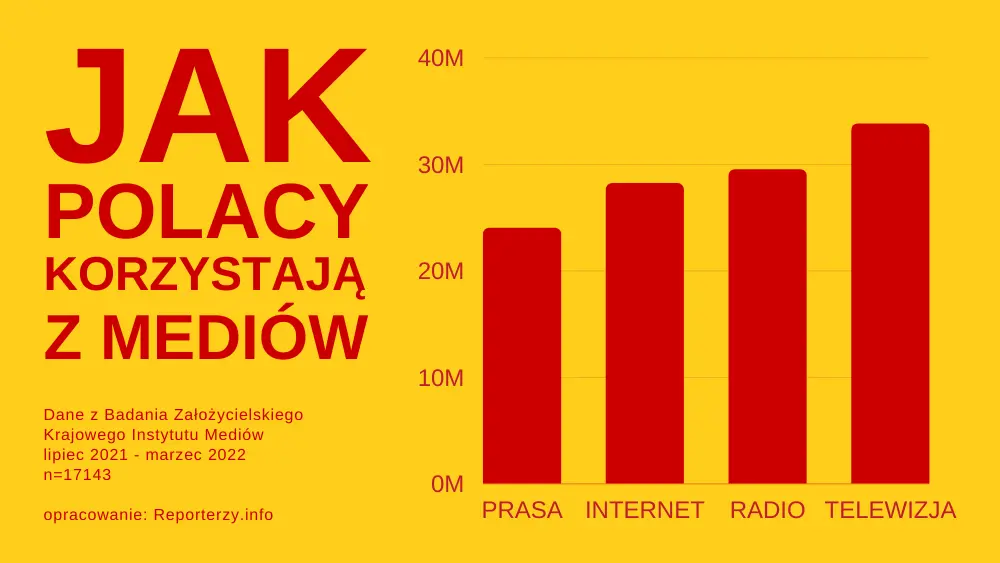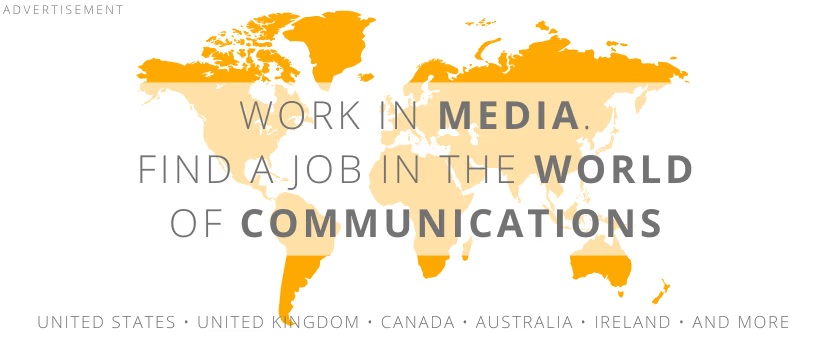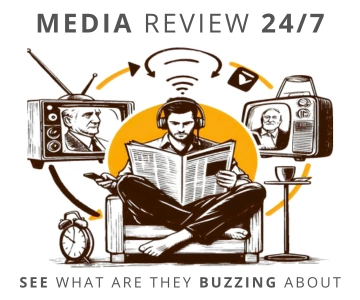 source: National Media Institute, analysis: Reporterzy.info, declarative data for the three months preceding the survey
source: National Media Institute, analysis: Reporterzy.info, declarative data for the three months preceding the surveyThe National Media Institute’s Establishment Survey provides insight into how and how often Poles use traditional and electronic media. Surveyors examined what devices people have at home and what they can access at work or school. The results are as follows:
- Access to TV: 92.0%
- Access to radio: 80.3%
- Access to a computer/tablet: 66.0%
- Access to a mobile phone/smartphone: 88.5%
However, access to a media device does not necessarily mean it is used regularly.
Television
In the 30 days preceding the survey, 90.2% of respondents reported watching television. This translates to 33.1 million Poles, but it’s only 96% of those with access to a TV. Conclusion: two million Poles could watch linear TV but choose not to.
In a longer, three-month period, 92.1% of respondents confirmed watching TV, equating to nearly 33.8 million people. Among age groups, those aged 65+ are the most frequent TV viewers.
- TV viewership by age group
- 4-9 years: 91.5%
- 10-15 years: 95.2%
- 16-24 years: 88.1%
- 25-34 years: 87.0%
- 35-44 years: 90.4%
- 45-54 years: 93.0%
- 55-64 years: 95.2%
- 65+ years: 95.9%
Radio
Radio listening was reported by 75.2% of respondents, meaning that 27.6 million people listened to the radio at least once in the past month. Among radio owners, nearly 8% did not turn on their device even once during the month before the survey.
In a three-month period, the number of radio listeners increases significantly, reaching 80.4% of the population, or 29.5 million people - 1.9 million more than in the one-month period. Radio is least popular among teenagers and most popular among those aged 35-44.
- Radio listenership by age group
- 4-9 years: 71.7%
- 10-15 years: 65.7%
- 16-24 years: 78.5%
- 25-34 years: 83.5%
- 35-44 years: 85.9%
- 45-54 years: 84.4%
- 55-64 years: 82.4%
- 65+ years: 77.9%
Internet
At least 76.8% of respondents use the internet occasionally. In a monthly timeframe, internet users slightly outnumber radio listeners at 28.2 million. According to the National Media Institute, the devices used to access the internet include:
- 26.4 million mobile phone owners (93.9% of internet users)
- 23.6 million computer and tablet owners (83.8% of internet users)
- 15.8 million Smart TV owners (56.2% of internet users)

Over three months, the number of internet users grows by just 300,000, indicating that those who use the internet tend to do so regularly. Among those aged 10 to 50, almost everyone surfs the web. However, over a three-month period, internet usage slightly trails radio usage.
- Internet usage by age group
- 4-9 years: 77.6%
- 10-15 years: 98.6%
- 16-24 years: 99.1%
- 25-34 years: 99.1%
- 35-44 years: 96.5%
- 45-54 years: 89.0%
- 55-64 years: 68.3%
- 65+ years: 28.7%
Print Media
Reaching for newspapers or magazines at least once a quarter is reported by 65.7% of respondents, equating to 24 million readers. Nearly half of this group also reads online editions. Over 11.3 million people, or 31% of the population, read e-publications. The older the age group, the higher the popularity of print media, with readership reaching up to three-quarters among the oldest Poles.
- Print readership by age group
- 4-9 years: 24.6%
- 10-15 years: 45.3%
- 16-24 years: 65.0%
- 25-34 years: 64.9%
- 35-44 years: 69.4%
- 45-54 years: 73.7%
- 55-64 years: 75.3%
- 65+ years: 72.8%
* * *
The National Media Institute’s Establishment Survey was conducted between July 2021 and March 2022 on a representative sample of 17,143 people aged 4 and older. Full results are available at https://kim.gov.pl/wyniki-badan/
COMMERCIAL BREAK
New articles in section Media industry
Advertising market 2025. Poland, Europe and the World
Marcin Grządka
The global advertising market is growing by 8.8% in 2025 and will reach a value of 1.14 trillion dollars. The industry result in Europe records slightly lower dynamics, at the level of 5.8%. In this comparison, Poland performs clearly above the average. We will record an increase of 8.9% this year and a value of 18.56 billion PLN - estimates WPP Media in the annual report "This Year Next Year".
The print media market 2025. Three global trends
Krzysztof Fiedorek
The market value is 359.53 billion dollars, yet the erosion is visible to the naked eye. The decline for newspapers will amount to -2.3 percent. Despite this, print retains strength: it generates 76 percent of subscription revenues and enjoys 82 percent consumer trust. The future of the industry is defined by hybrid strategies and niche specialization.
Journalism in the age of AI. Why people prefer humans over machines
Krzysztof Fiedorek
Only 12% of people accept news created solely by AI, while 62% prefer those written by humans. At the same time, only 19% notice labels indicating the use of artificial intelligence, while younger audiences ask AI to explain the content to them. These are the findings of the Reuters Institute report on artificial intelligence in media.
See articles on a similar topic:
Poles on the Internet. RegionyNEXERY 2024 Report
KFi
The Internet not only connects people but also changes their daily habits in ways that seemed unattainable just a few years ago. Over 40% of Poles work remotely, and IoT devices are gaining popularity in rural areas. The #RegionyNEXERY 2024 report reveals surprising facts about the digital reality.
Yellow Press. What is Yellow Journalism?
Krzysztof Fiedorek
The terms "yellow press" and "yellow journalism" are often used pejoratively to describe journalistic practices focused on sensationalism, gossip, and emotions rather than objective facts. Let’s explore their origins, distinctive features, and impact on society.
Dead internet theory is a fact. Bots now outnumber people online
Krzysztof Fiedorek
Already 51% of global internet traffic is generated by bots, not people. As many as two-thirds of accounts on X are likely bots, and on review platforms, three out of ten reviews weren't written by a human. Do you feel something is off online? It's not paranoia. In 2025, it's a reality.
Women in media 2025. Editorial power knows no equality
KFi
Only 27% of editors-in-chief in the media are women, even though they make up 40% of journalists. In 9 out of 12 countries studied by the Reuters Institute, women in media are less likely to get promoted. It seems that equality in newsrooms is lagging behind broader society. And the gaps go much further.





























